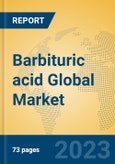Regional Market Dynamics
Asia-Pacific dominates barbituric acid production and consumption, with China serving as the primary manufacturing hub due to established chemical industry infrastructure and competitive production costs. The region benefits from proximity to major vitamin manufacturers and pharmaceutical companies, creating integrated supply chain advantages. India demonstrates growing importance as both a production center and consumption market, driven by expanding generic pharmaceutical manufacturing and increasingNorth America and Europe represent significant consumption markets, particularly for high-purity grades used in pharmaceutical applications. These regions emphasize quality standards and regulatory compliance, supporting premium pricing for certified products.
- vitamin production capacity. The country's growth rate in barbituric acid consumption is estimated at 4.0%-5.5% annually, reflecting robust pharmaceutical sector expansion.
- European markets show steady demand growth at 2.5%-3.5% annually, supported by established pharmaceutical industries and stringent quality requirements that favor reliable suppliers with comprehensive documentation and certification capabilities.
Application Segments and Growth Trends
- Vitamin synthesis represents the largest application segment for barbituric acid, with particular emphasis on Vitamin B2 (riboflavin) and Vitamin B12 (cobalamin) production. This segment demonstrates strong growth at 3.5%-4.8% annually, driven by expanding global vitamin market demand and increasing nutritional supplement consumption.
- Pigment manufacturing represents a specialized but significant application area, with barbituric acid used in synthesizing Pigment Yellow 139 and Pigment Orange 64. This segment shows moderate growth at 2.5%-3.8% annually, supported by steady demand from coating, plastic, and printing ink industries.
- Pharmaceutical drug synthesis, particularly barbiturate medications, maintains steady demand despite declining use of traditional barbiturate drugs. Growth rates in this segment range from 2.0%-3.2% annually, reflecting specialized therapeutic applications and research requirements.
Key Market Players and Production Capacity
The barbituric acid market is characterized by a concentrated supplier base, with four major Chinese manufacturers dominating global production capacity.- Anshan Hifichem Co. Ltd. operates the largest production facility with 4,000 tons annual capacity, positioning the company as a leading supplier to vitamin and pharmaceutical manufacturers. The company emphasizes quality control and regulatory compliance to serve international markets.
- Shijiazhuang Jackchem Co. Ltd. maintains 3,000 tons annual capacity, focusing on high-purity grades for pharmaceutical applications. The company has established strong relationships with major vitamin manufacturers and maintains comprehensive quality assurance systems.
- Zhengzhou Lifeng Chemical Co. Ltd. operates 2,000 tons annual capacity, specializing in both pharmaceutical and pigment applications. The company's diversified approach provides market stability and risk mitigation across different end-use sectors.
- Ronak Chemicals, with 1,200 tons annual capacity, serves specialized markets and maintains flexibility in product specifications. The company focuses on customer service and technical support to differentiate its offerings in the competitive marketplace.
Porter Five Forces Analysis
- Supplier Power: High, due to the concentrated nature of raw material suppliers and specialized production requirements. Key intermediates for barbituric acid synthesis are available from limited sources, creating supplier leverage over pricing and terms.
- Buyer Power: Moderate to high, as major vitamin and pharmaceutical manufacturers represent large-volume customers with significant negotiating power. However, switching costs and quality requirements limit buyer flexibility.
- Competitive Rivalry: Moderate intensity, with established players competing primarily on quality, reliability, and price. The concentrated supplier base and specialized applications limit intense price competition while emphasizing service differentiation.
- Threat of Substitutes: Low to moderate, as barbituric acid's unique chemical properties make it difficult to substitute in key applications. Alternative synthetic pathways exist for some applications but often prove less economical or efficient.
- Barriers to Entry: High, requiring substantial technical expertise, regulatory approvals, and capital investment for production facilities. Quality certification requirements and established customer relationships create significant hurdles for new market entrants.
Market Opportunities and Challenges
- Opportunities:
Pharmaceutical industry evolution, including generic drug development and novel therapeutic compounds, presents opportunities for specialized barbituric acid applications. Research into new barbiturate derivatives for specific medical conditions may create additional demand segments.
Emerging markets in Asia, Africa, and Latin America show increasing pharmaceutical manufacturing activities, creating new customer bases and regional demand centers. Government initiatives supporting local pharmaceutical production enhance market expansion potential.
- Challenges:
Environmental regulations affecting chemical manufacturing create operational challenges and potential cost increases. Waste treatment and emissions control requirements necessitate ongoing facility upgrades and process improvements.
Raw material availability and pricing volatility impact production costs and margin stability. Supply chain disruptions can significantly affect production schedules and customer relationships, requiring robust contingency planning and supplier diversification strategies.
Market concentration among both suppliers and customers creates risks from consolidation activities and changes in customer preferences or requirements. Maintaining technological competitiveness requires ongoing research and development investments despite the market's niche nature.
This product will be delivered within 1-3 business days.
Table of Contents
Companies Mentioned
- Ronak Chemicals
- Shijiazhuang Jackchem Co. Ltd.
- Zhengzhou Lifeng Chemical Co. Ltd.
- Anshan Hifichem Co. Ltd.








